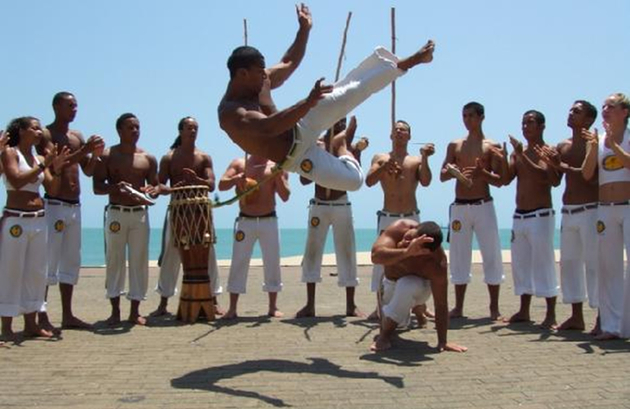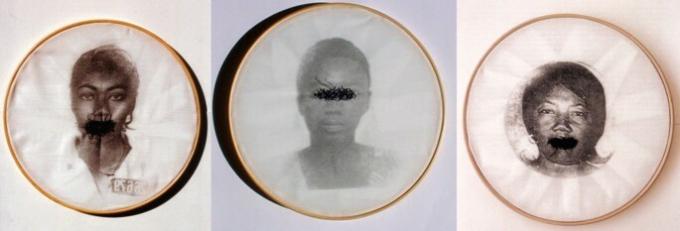Capoeira is a Brazilian cultural expression that comprises the elements: martial art, sport, popular culture, dance and music.
It builds relationships of sociability and familiarity between masters and disciples, being spread by word of mouth and gestures in the streets and academies.
Capoeira was created in the 17th century by the enslaved people of the Bantu ethnicity and spread throughout Brazil. Today it is considered one of the greatest symbols of Brazilian culture.

Capoeira Characteristics
- music accompaniment: berimbau, singing and clapping;
- wheel formation: capoeira wheel;
- capoeirista graduation made by ropes of different colors tied around the waist.
A characteristic that distinguishes capoeira from other fights is the fact that it is accompanied by music.
It is the music that decides the rhythm and style of the game, which is played during the capoeira wheel, a circle of people where capoeira is played.
Thus, the capoeiristas line up in the capoeira roda, clapping their hands in the rhythm of the berimbau while singing for the two practitioners to play.
The berimbau is a stringed musical instrument made of wood, bamboo, wire and a gourd.
The game can end at the command of the capoeirista in the berimbau (usually a more experienced capoeirista), or with the beginning of a new fight between a new pair.
The music, in turn, is composed of instruments and songs, where the rhythm varies according to the 'capoeira touch', which varies from slow (Angola) to very fast.
In capoeira regional or capoeira angola groups, graduation is simulated by the colors of ropes tied around the player's waist.
Capoeira blows
Capoeira is characterized by agile and intricate strikes and movements. It mainly uses movements made close to the floor or upside down.

The most common scams are:
- kicks;
- creeping;
- halters;
- knees;
- elbows;
- ground or aerial acrobatics.
Therefore, capoeira is a fight of defense and attack in which opponents use, above all, their feet and head.
Types of Capoeira
The two main types of capoeira are Angola and Regional.
Capoeira Angola
Angola is the original style practiced by slaves. This way of playing capoeira is characterized by being slower, made up of furtive movements and performed in a creeping way.
The basic component of this style is malice. This "trickery" consists of simulating moves that serve as a decoy to the opponent in combat.
Regional Capoeira
Capoeira Regional is the contemporary style of capoeira. She has attributes of other martial arts in her practice.
This style was created by Mestre Bimba and quickly spread around the world. This contributed to improve the image of the capoeirista at the same time that it favored the increase of its adepts.
Differences between Capoeira Angola and Capoeira Regional
Watch a video in which capoeirista Dija Damasceno explains the difference between the two existing styles of capoeira.
Origin and History of Capoeira
The word capoeira means "what was killed", by connecting the terms ka'a ("kills") and put ("what it was"). It alludes to the areas of shallow forest in the interior of Brazil, where indigenous agriculture was carried out.
It has its origins with the fugitives from slavery, who often used the undergrowth to escape from the footsteps of the captains-do-mato. These were the first capoeiristas.
Later, still in the colonial period, blacks disguised capoeira by introducing mimes, dances and songs. All this served to resist the repression of the Imperial Police and the Republican Militia.

Capoeira was a prohibited practice in Brazil until 1930, when it came to be recognized as a symbol of Brazilian identity. In 2014, the Roda de Capoeira was declared an Intangible Cultural Heritage of Humanity by Unesco.
Curiosities about Capoeira: Did you know?
- An experienced capoeirista who ignores musicality is considered incomplete. He must be able to play the typical instruments, sing and clap during the capoeira game.
- Other cultural demonstrations, such as maculelê and samba de roda, are closely associated with capoeira, although they have different ancestry and meanings.
Capoeira Music
what ship is this
that arrived now
it's the slave ship
with the slaves of Angola
people come from Cambinda
Benguela and Luanda
they came in chains
to work in these bandswhat ship is this
that arrived now
it's the slave ship
with the slaves of Angola
arriving here did not lose their faith
created the samba
capoeira and candombléwhat ship is this
that arrived now
it's the slave ship
with the slaves of Angola
chained in the ship's hold
many died of banzo and cold
Folklore Quiz
Don't stop here, check out other related texts that Toda Matéria prepared for you:
- Brazilian folklore
- Samba de Roda
- congada
- Kings' Folia
- Maracatu
- Afoxe
- Judo


